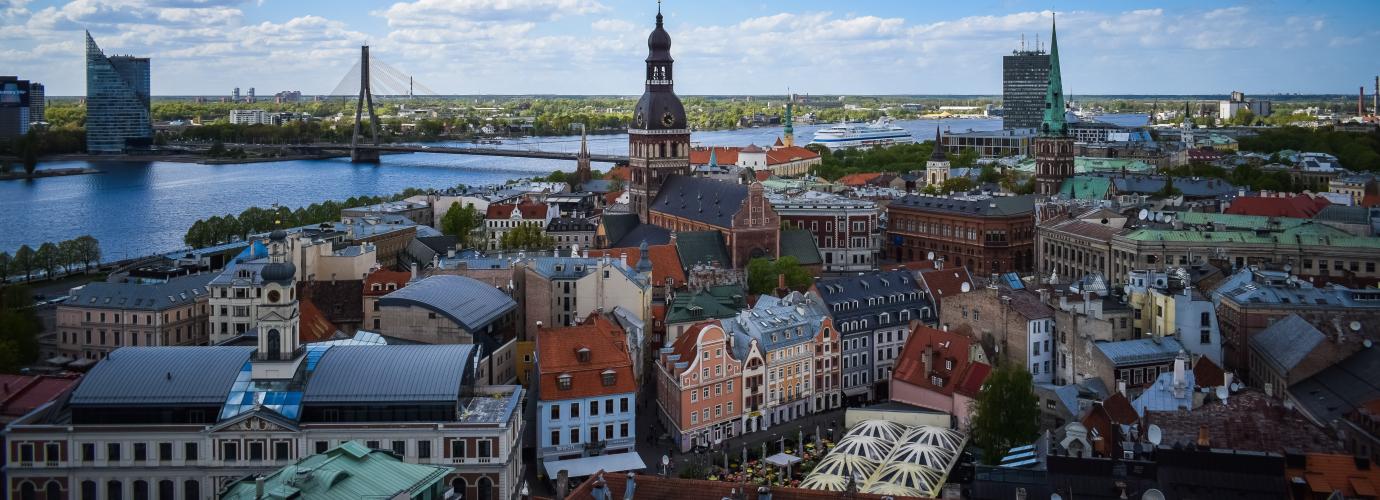Latvia is a small, open economy with exports contributing significantly to gross domestic product (GDP). Due to geographical location, transit services are highly-developed, along with timber and wood-processing, agriculture and food products, and manufacturing of machinery and electronic devices. Latvia's low birth rate and decreasing population are major challenges to long-term economic vitality and has notable influence on the education system – creating the necessity to reduce the number of educational institutions by optimising their network and raising overall competitiveness.
The past decade has been a turbulent period for the Latvian economy. From acquiring double digit growth figures before 2008, the country has first experienced a double digit drop in GDP before rebounding to a healthier economy and more focus on socioeconomic challenges.
Economic crisis and its aftermath
From 2008 to 2010 the Latvian economy took one of the sharpest downturns in the world, when the fall of GDP reached 21%. The financial assistance of the European Union, the IMF, and the World Bank supported the economic recovery program. Latvia returned to growth in the latter half of 2010 as a result of economic stabilization measures.
At present, Latvia continues to show rapid and sustainable growth. Latvia still continues structural reforms towards improving competitiveness and productivity.
Current economic situation
Data compiled by the Central Statistical Bureau show that in 2018 economic growth continued, as gross domestic product (GDP) increased by 4.8 %, compared to 2017. In 2018, the sharpest GDP rise over the past seven years was recorded.
In 2018, compared to 2017, the total compensation of employees increased by 11 %, of which total wages and salaries by 10 % and social security contributions of employers by 15 %. The sharpest rise was recorded in information and communication (of 20 %) and construction (18 %).
State expenditure on education as % of gross domestic product:
Year 2000 5.6%
Year 2010 5.0%
Year 2015 5.9%
Year 2020 5.9%
Source: Eurostat, General government expenditure by function (COFOG)
With the 2014 Latvia has joined the Eurozone and the Euro has become the official currency of the country.
Most recent information on the country’s economic situation available at Bank of Latvia Macroeconomic Developments Report.
Latvia’s Presidency of the Council of the European Union
Latvia held the Presidency of the Council of the European Union in the first half of 2015. The Presidency of Latvia organised the Eastern Partnership Summit, the Fifth Meeting of the Ministers of Education of the ASEM countries and the Conference of European standardization.
According to a current decision, Latvia will hold the presidency of the Council of the EU again in July-December 2028.
The influence of political and social situation on education
Due to notable cut in the education budget during the crisis and taking into account the decrease of the number pupils and students due to socioeconomic and demographic factors significant structural reforms have been performed in the whole education system:
- In general education an optimisation of school network is continuing.
- In vocational education reduction of the number of institutions and development of vocational training competence centres in regions was started by allocating EU Social and Regional Development Funds for development and adjustment of curriculum and vocational training standards according to labour market needs and modernisation of the teaching supply and infrastructure.
- In the field of higher education – a new performance-based funding model was prepared and the EU Social and Regional Development Funds were allocated for improvement and development of study programmes and modernisation of the infrastructure of the higher education.
The educational attainment level of the adult population
Latvia has been successful in making upper secondary attainment universal. Nearly 90% of the adult population (25-64 year-olds) in Latvia have attained at least upper secondary education, 10 percentage points above the OECD average of 80%. Of the remaining 10%, everyone completed at least lower secondary education (Source: Education at a Glance 2017, Country Note Latvia).
In 2018, 34% of the Latvian population aged 25-64 years old had attained a tertiary education compared to the OECD average of 37%, although the rate has improved among young adults (25-34 year-olds) from 29% in 2008 to 42% in 2018. However, the gender distribution of tertiary qualifications among young adults is uneven: tertiary educational attainment is much lower among men (30%) than among women (54%). Latvia has the largest gender gap in tertiary educational attainment among OECD and partner countries and it is wider for the younger generations (Source: Education at a Glance 2019, Country Note Latvia).

